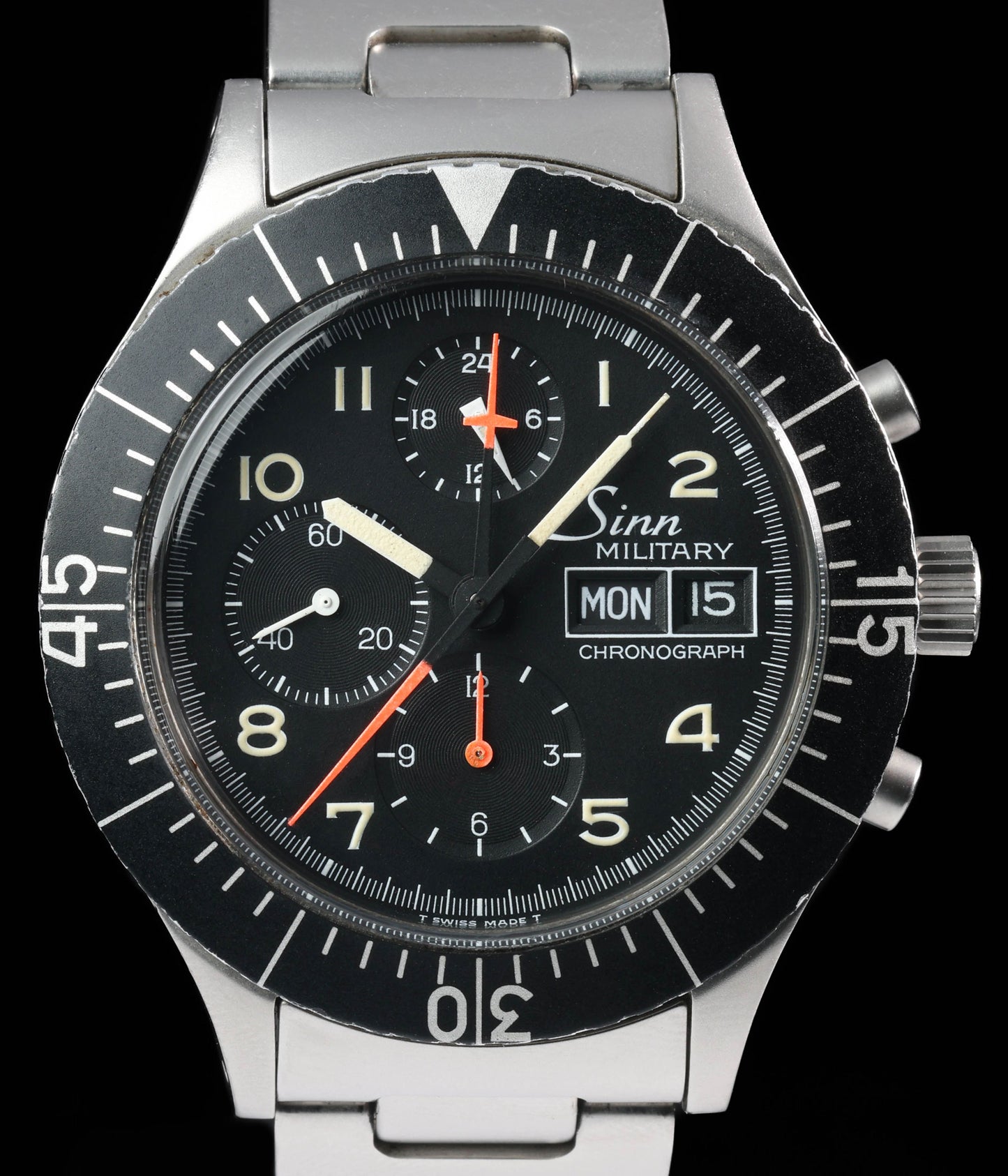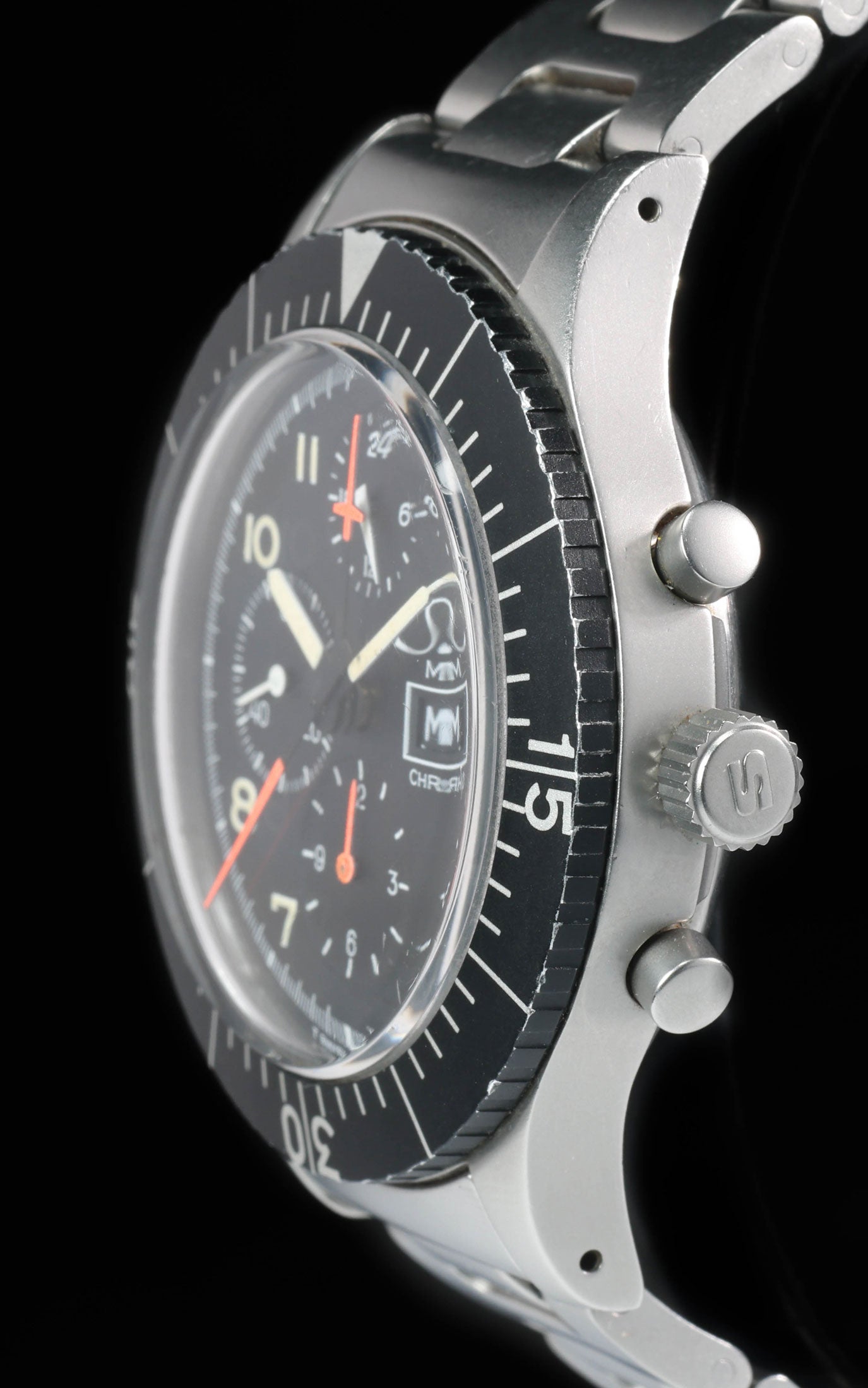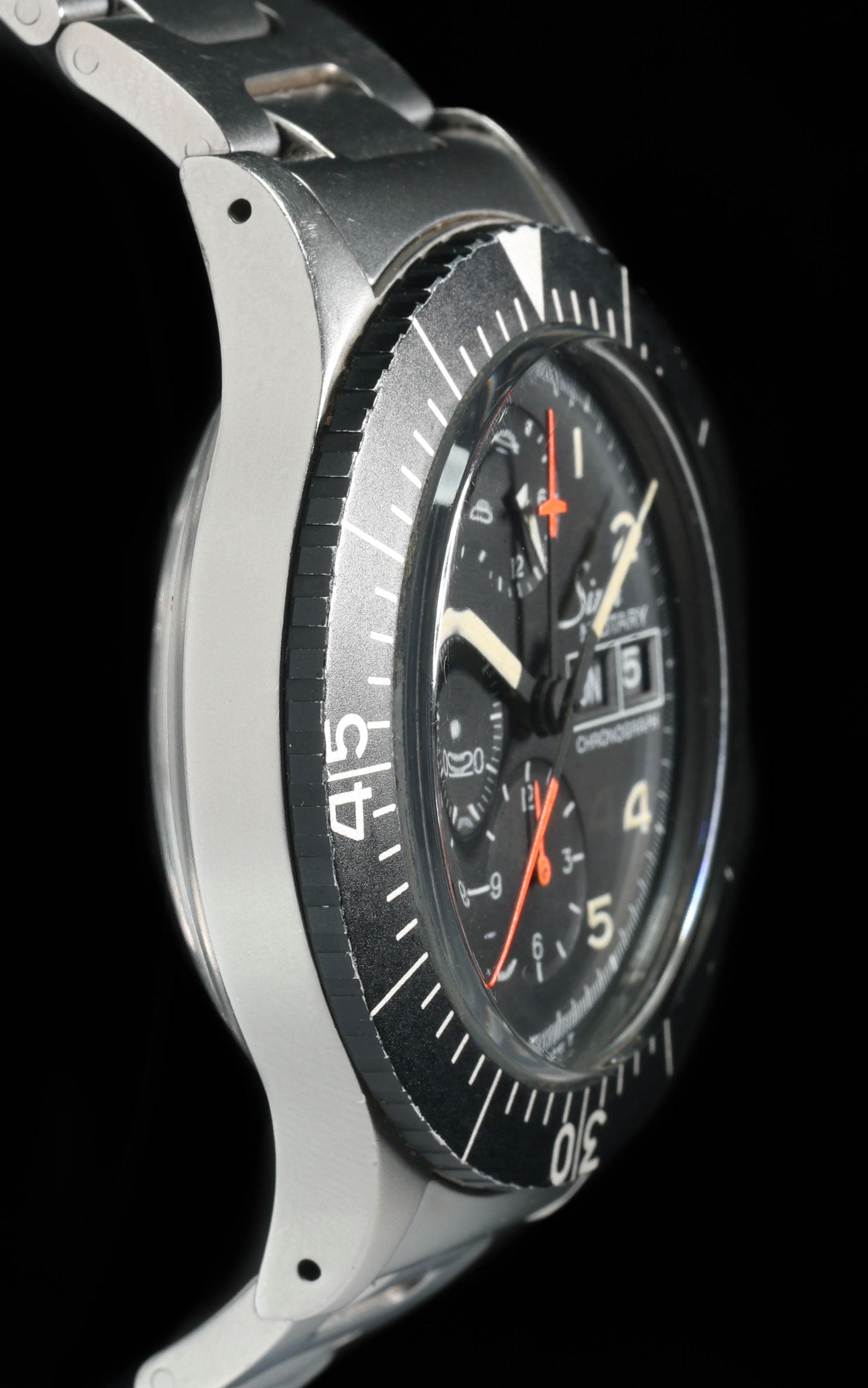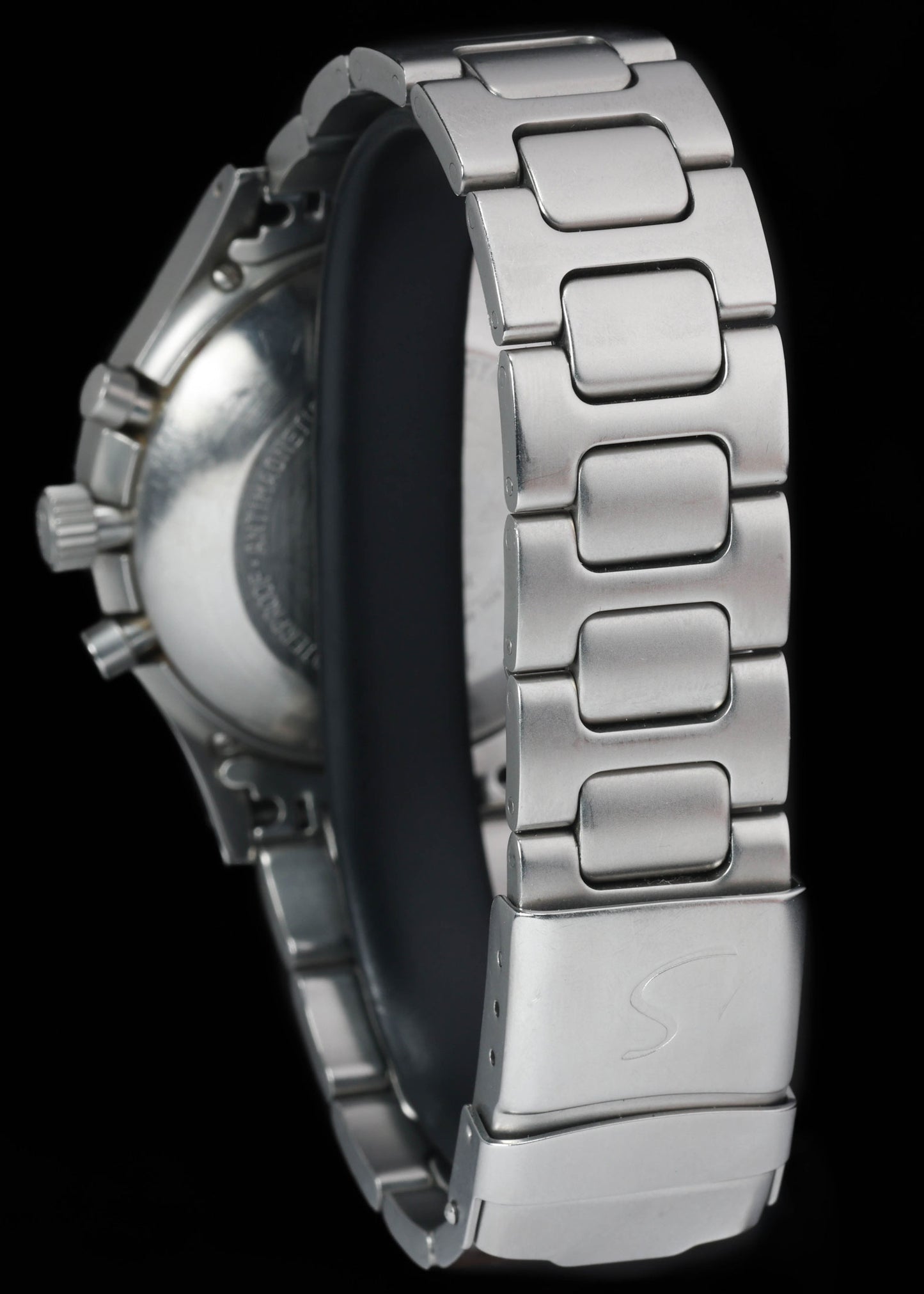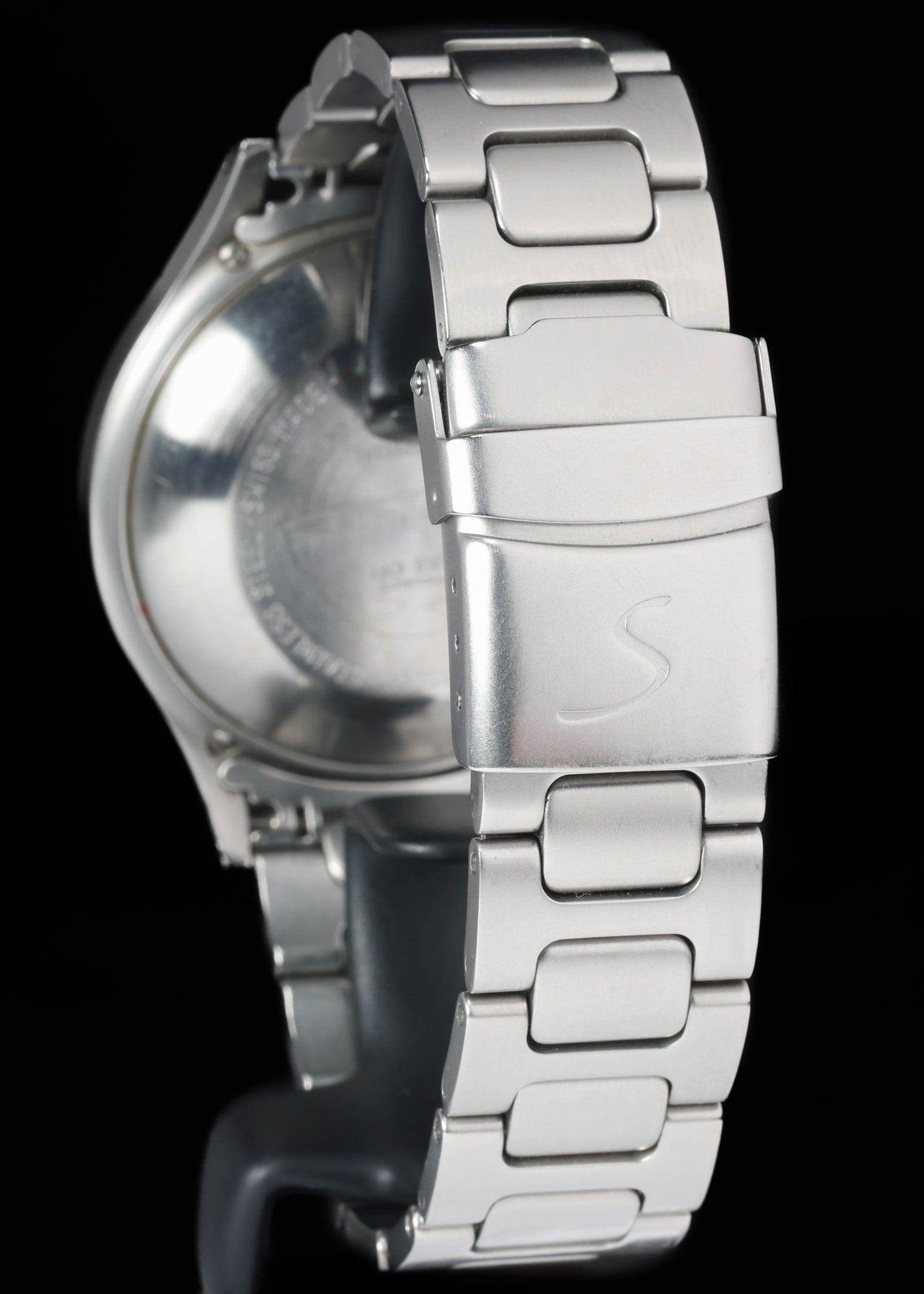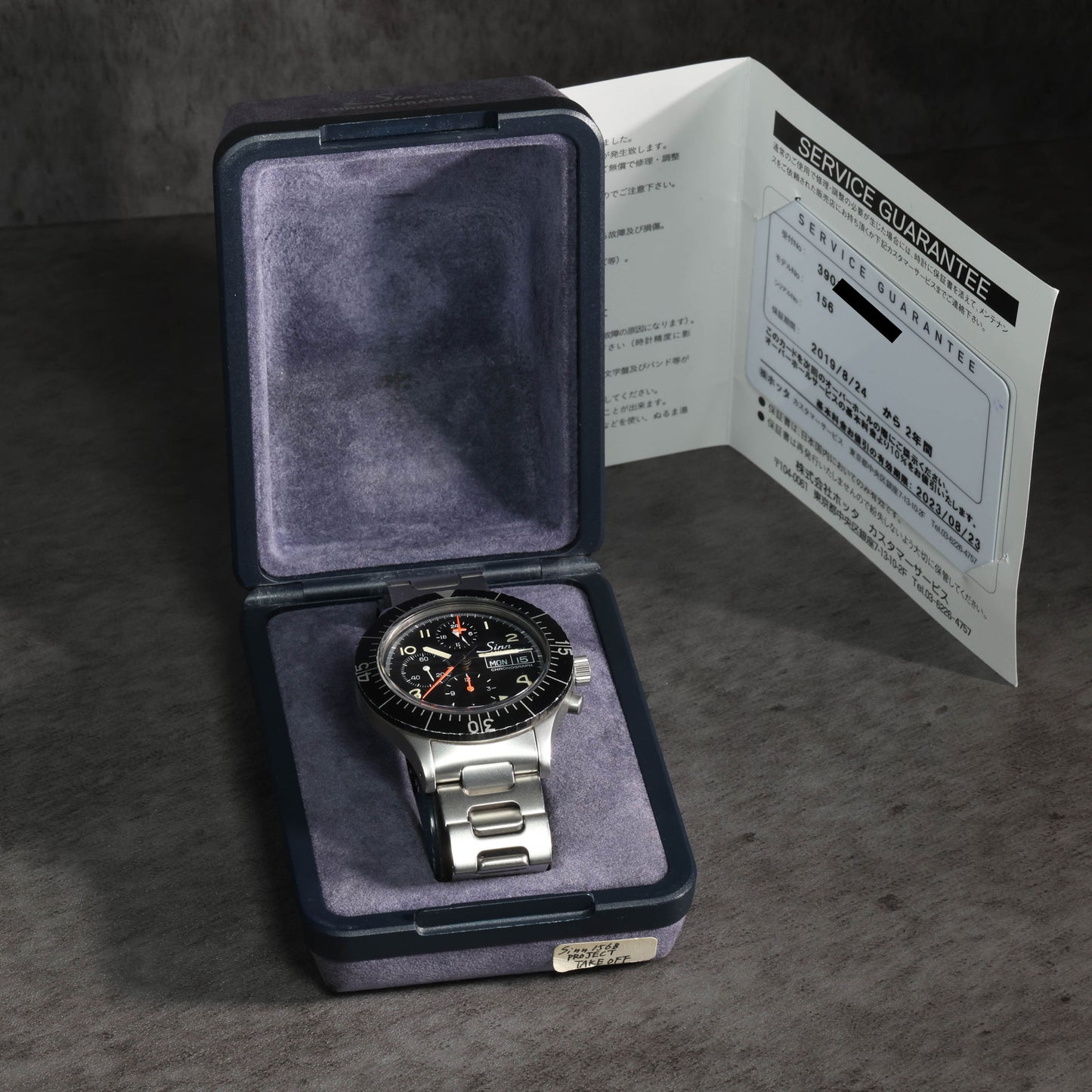Crown Vintage
Sinn 156.B Military Chronograph 43MM Circa 1990
Sinn 156.B Military Chronograph 43MM Circa 1990
Couldn't load pickup availability
Sinn 156.B Military Chronograph
Case presents in excellent vintage condition with only light, superficial hairlines visible under close inspection and no loss of definition to the bead-blasted surfaces. Bracelet remains tight, showing minimal stretch and just faint hairlines on the clasp and links while retaining its original matte finish. Dial and hands exhibit an attractive, even patina across the Tritium lume with no flaking, giving the watch consistent aged character without affecting legibility. Acrylic crystal is clear and free of cracks or deep marks, and the crown, pushers and bezel all operate crisply. Now more than 30 years old, this chronograph must be treated as a vintage timepiece—keep it away from the pool and never wear it in the shower, even if it was rated for water resistance when new.
Share
Why we love this watch
Why we love this watch
Sinn 156.B Military Chronograph 43 MM
Origins of the Sinn 156.B
When Helmut Sinn set out to create a successor to the legendary Heuer-Bund pilot’s chronograph, he combined surplus military know-how with modern automatic technology. The result was the Sinn 156, introduced in the late 1980s as a candidate for the next Bundeswehr cockpit watch. By marrying the familiar asymmetrical “Bund” case profile to the newly available Lemania automatic chronograph movements, Sinn produced a watch that echoed the earlier Model 155 but offered all-new capability for pilots at the dawn of the 1990s. Although the Luftwaffe contract ultimately went to Tutima, Sinn pressed on and commercialised the watch as the 156.B, making the model available to both professional aviators and civilians from around 1990.
Despite its military styling, the 156.B never became an issued timepiece. By the time it was ready, Germany was unifying and defence procurement had shifted; the golden era of purpose-issued pilot watches was drawing to a close. Instead, the 156.B built its own following among private pilots and chronograph enthusiasts who valued Sinn’s no-nonsense approach and the tactile appeal of the Lemania movement.
Case and Bezel: 43 MM Combat-Ready Architecture
At 43 mm across, 51 mm lug-to-lug and around 15.5 mm thick, the bead-blasted steel case feels purposeful without sliding into modern oversize territory. The shoulders flow into relatively narrow lugs drilled for 20 mm spring bars, echoing its Heuer forebear while improving strap versatility. Its multi-part construction, secured by four lateral screws, keeps servicing straightforward and allows precise alignment of the case-back gasket. A tall acrylic crystal rises a millimetre or two above the pilot bezel, enhancing vintage charm and keeping glare low in bright light.
The bidirectional aluminium bezel features a simple 60-minute scale with the classic triangle at 12. Because there are no click-stops, timing adjustments can be made silently—handy when cockpit noise is already overwhelming—and the anodised surface can be read at a glance even after dusk thanks to the luminous reference pip.
Movement: Lemania 5100—The Workhorse in Uniform
Inside ticks the much-loved Lemania 5100, famed for its shock resistance, unpretentious finishing and central-minutes layout. This cam-lever chronograph hides a secondary plastic braking gear to absorb shocks, an innovation that allowed military pilots to operate the pushers at high G-loads without risking hand jump. Central chronograph minutes eliminate the clutter of a small counter and let elapsed timing be read instantly, a genuine safety gain over conventional sub-dial designs. The movement adds a 24-hour hand at 12, day-date display at 3 and a 12-hour totaliser at 6, while the running seconds ticks away at 9. A 42-hour power reserve and hacking function round out the spec sheet.
Although production of the Lemania 5100 ceased in 2002, its reputation as a “fit-and-forget” military calibre remains intact. Many professional operators swore by its gritty winding feel and the satisfyingly crisp “crunch” of its pushers, trusting it in aircraft, armoured vehicles and on the wrists of rescue personnel.
Dial Layout: Built for Instant Legibility
The 156.B dial stays utterly functional: matte black base, stark white printing and blocky Tritium lume plots. A vivid syringe-tipped seconds hand and orange-red central minutes hand form the signature cross-hair synonymous with Lemania-powered chronographs. The sub-dial quartet—24-hour at 12, running seconds at 9, 12-hour counter at 6 and framed day-date at 3—creates perfect north-south-east-west symmetry, making orientation effortless when a pilot glances down mid-manoeuvre. Broad baton hour and minute hands, also Tritium-filled, complete the low-light equation, while the dial text is kept restrained: simply “Sinn” and “Automatic” or, on a few pieces, “MILITARY”.
Wearing Experience and Ergonomics
On the wrist the 156.B delivers the unmistakable presence of a mission-built tool yet balances neatly thanks to a case weight of roughly 70 g head-only. A relatively flat case-back spreads the mass, and the modest bezel overhang means it slips under a flight jacket cuff. The standard H-link steel bracelet offers ratcheting micro-adjustment and tapers subtly to avoid wrist-top bulk, but many owners prefer a leather bund pad or a nylon NATO for period-correct flair. Fixed bars were never fitted—Sinn chose conventional spring bars to keep strap changes quick—so experimenting with straps poses no challenge.
Operational Context and Field Performance
Although never officially adopted, the 156.B borrowed heavily from the Bundeswehr spec sheet. Stainless steel was blasted matte to kill reflections; push-pieces sat flush to reduce snag risk; and the crown screwed down to protect the movement against pressure changes during rapid altitude shifts. Reports from private pilots and sky-divers of the 1990s confirm that the watch shrugged off vibration, temperature swings and G-forces that rattled lesser chronographs. That resilience stemmed not just from the hardy Lemania but also from Sinn’s focus on silicone-greased seals, a reinforced crystal seat and a movement ring that doubled as a shock absorber.
Evolution and Production Span
Sinn produced several dial variations throughout the 1990s, but the reference 156.B is generally identified by its plain “Sinn” logo, no military crest, and a serial range that points to assembly around 1990-1993. Many early examples feature signed screw-down crowns and case-backs numbered around the perimeter. Later pieces adopted a slightly thicker handset to meet evolving lume regulations, but the essential architecture remained unchanged until the model was withdrawn following Lemania’s closure in the early 2000s.
Everyday Practicality in 2025
Three-plus decades on, the 156.B still feels relevant. The big dial reads quicker than most smart-watch screens and the bezel doubles as a ready countdown for parking meters or pourover coffee. Modern owners often swap the acrylic crystal for a low-domed mineral replacement to keep scratches at bay, but many retain the original for its authentic aviation haze. At 20 mm lug width, contemporary strap makers offer countless options—from Cordura to kangaroo leather—allowing a personal style twist without compromising heritage.
Final Thoughts
The Sinn 156.B is a living snapshot of late-Cold-War watchmaking: large, legible and engineered with the single purpose of keeping pilots safe and on schedule. Its 43 mm bead-blasted shell, Lemania 5100 heart and cockpit-inspired dial all speak to an era when instruments were built for survival rather than status. Remember, though, this chronograph is now well over 30 years old. Treat it as the vintage time-piece it is: enjoy it on dry land, dodge the pool and definitely leave it off in the shower, even if the original spec sheet boasted admirable water resistance. Respect those simple limits and the 156.B will keep bringing cockpit clarity to daily life for decades more.
Case & Bracelet
Case & Bracelet
Case remains in great condition. Minimal hairlines visible. Bracelet has minimal stretch and hairline visible.
Dial & Hands
Dial & Hands
In excellent condition. Even patina forming.
Warranty & Condition
Warranty & Condition
Crown Vintage Watches provides a minimum 3-month mechanical warranty on pre-owned watches, from the date of purchase.
The warranty covers mechanical defects only.
The warranty does not cover damages such as scratches, finish, crystals, glass, straps (leather, fabric or rubber damage due to wear and tear), damage resulting from wear under conditions exceeding the watch manufacturer’s water resistance limitations, and damage due to physical and or accidental abuse.
Please note, water resistance is neither tested nor guaranteed.
Shipping and insurance costs for warranty returns to us must be covered by the customer. Returns must be shipped via traceable courier. Return shipment must be pre-paid and fully insured. Collect shipping will be refused. In case of loss or damages, the customer is liable.
Our Pledge
At Crown Vintage Watches, we stand by the authenticity of every product we sell. For added peace of mind, customers are welcome to have items independently authenticated at their own expense.
Condition
Due to the nature of vintage timepieces, all watches are sold as is. We will accurately describe the current condition and working order of all watches we sell to the best of our ability.
Shipping & Refund
Shipping & Refund
